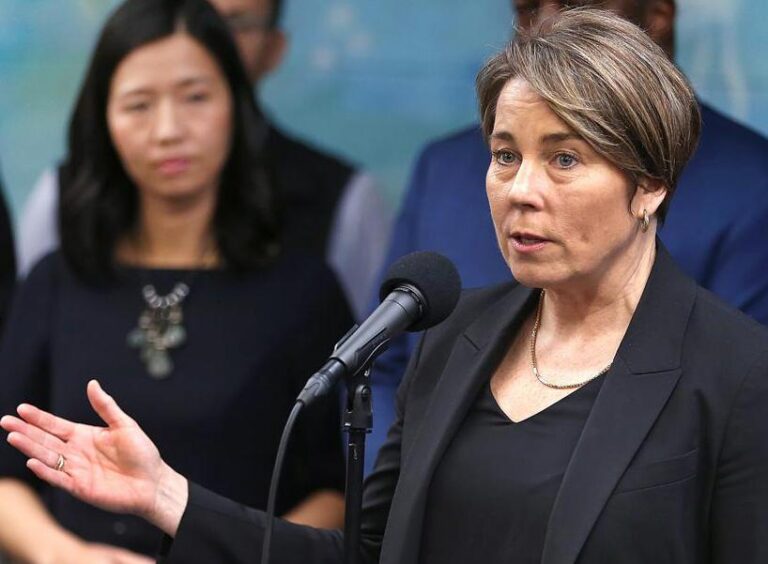Governor Maura Healey’s administration is washing its hands of the Boston Public Schools. That’s the only conclusion I could draw this week after watching state officials all but abandon the effort started under Healey’s predecessor to pressure BPS into improving its academic performance.
Wielding the threat of a state takeover, officials in 2022 put the district on an improvement plan. That was under former governor Charlie Baker. But now the heat is off. Despite calls to extend the improvement plan, the state will wrap up its oversight this summer.
There has been some progress. But the district failed to meet several of its goals, and the goals it did meet have not translated into sustained academic gains. If parents were hoping that the state would hold the district accountable for those failures, it’s now clear — it won’t.
Test scores have continued to decline, with more than a third of BPS students now attending so-called transformation schools, which are the bottom 10 percent of schools statewide. The district’s bus system, long a symbol of BPS dysfunction, still fails to meet on-time performance benchmarks.
So what was the point of the past three years?
From the perspective of BPS Superintendent Mary Skipper, things are looking up. In a memo to the school community, Skipper cheered the conclusion of the systemic improvement plan, calling it “a significant step forward’’ and touting “data and evidence of improvements across our operations.’’ She pointed to progress in areas like transportation, safety, and data governance, and to her credit, BPS has made modest expansions in programs for English learners.
In an interview, Skipper strongly disagreed with my view that the state is now walking away from its accountability role. “The goal of this was, in a variety of areas, to show that we were stable, that we had the systems and the structures to be able to continue good work,’’ Skipper told me. “If you look at BPS’s academic data and performance, we actually are outperforming a number of other districts that would be considered urban districts with our same profile’’ in the state. “We also have said very clearly … that we have additional work to do.’’
For instance, on transportation, the district saw an average of 94 percent on-time bus performance this month so far, according to a spokesperson. That’s for morning buses only, though, and still short of the 95 percent benchmark established in the plan. “On-time performance is an important measure and one that we will continue to track, but it’s also about the experience on the bus,’’ like the number of missed routes, Skipper said, referring to other metrics the district tracks.
All the same, the state’s intervention has largely failed to improve academic outcomes overall, particularly for historically marginalized groups such as Black and Latino students, multilingual learners, students with disabilities, and low-income students, as detailed in a recent Boston Policy Institute report.
From 2019 to 2024, the district actually “increased the number of schools in the lowest-performing 10 percent in the state from 34 to 36,’’ Kerry Donahue, the author of the report, wrote. (Two of those schools, the Shaw and the Taylor, merged at the beginning of the current school year. While state data doesn’t reflect that merger yet, BPS does and puts the number at 35.) “On their own, these schools would constitute the fifth-largest district in the state. On average, the achievement of students in these schools has significantly declined.’’
Despite the focus of the plan on improving BPS transformation schools, Donahue said that “in Grades 3-8 across all transformation schools, MCAS proficiency declined significantly from 2019 to 2024 in English language arts and in math.’’ On a good note, proficiency improved by 1 percentage point in English language arts on the Grade 10 MCAS in the same period, she said.
Part of the problem is that the state never tied its oversight to clear academic benchmarks. In fact, Donahue found that the district “met 75 percent of what was asked for,’’ she told me. “I think [the district] used the language of stability. To some extent that has happened.’’ But “the real changes that are supposed to impact the quality of schools and outcomes for historically marginalized students, those really have not shifted, and many have gotten worse,’’ she said.
That’s why Donahue recommended that a new agreement be put in place prioritizing student outcomes in literacy, math, and postsecondary/workforce readiness, with measurable targets for increasing access to high-quality schools for high-need students. “We’ve seen over the years that Boston is not able to hold itself accountable for improvement in student outcomes,’’ Donahue said. “The incremental [movement] tends to win out from making the changes that are most necessary to advance those outcomes.’’
A new agreement is not going to happen, though; the current one expires over the summer.
Will Austin, a Boston-based education consultant, says the state is making a mistake by letting Boston off the hook. “Pressure from the state was a very important lever for a very long time in Massachusetts education policy,’’ he said. “Schools generally only receive additional support or reform in response to some form of pressure … whether it’s legal pressure, electoral pressure, political pressure, or pressure from the state.’’
Meanwhile, through a spokesperson, Massachusetts Secretary of Education Patrick Tutwiler declined to answer my questions about the effectiveness of the state’s intervention in BPS, lessons learned, and what circumstances would trigger further oversight in the future. Instead, the spokesperson shared a recording of a short interview that the outgoing acting commissioner of elementary and secondary education in Massachusetts, Russell Johnston, gave to a Globe colleague earlier this week.
“The [systemic improvement plan] was designed as a three-year process,’’ Johnston said. As that period comes to an end, Johnston said the state’s work will continue in a different way. “We have very pertinent, timely monitoring tools that we want to use with the district.’’ For instance, Johnston said BPS is currently undergoing a monitoring review that’s looking at issues around special education and civil rights.
That may be true, but it’s clear the pressure is now fading. And with it, so is any real urgency to fix the deep-seated problems that keep failing BPS students year after year. The state’s retreat is not a sign of success — it’s an abdication of responsibility. Massachusetts leaders once insisted that Boston’s schools were too broken to be left alone. They were right. And yet, that’s exactly what they’re doing.
Marcela García is a Globe columnist. She can be reached at marcela.garcia@globe.com. Follow her on X @marcela_elisa and on Instagram @marcela_elisa.


